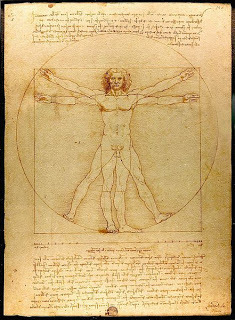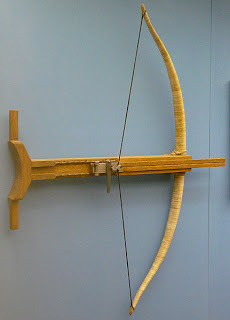Bish Bash Bosh – Ancient Artillery Part One
 The man who inspired this famous image; a Renaissance tip of the hat to the mathematical and scientific accomplishments of the classical world, was the Roman architect Marcus Vitruvius Pollio, who dedicated his most famous treatise De Architectura to the emperor Augustus. Vitruvius, like all good Romans had done his time in the army and had campaigned under Julius Caesar, serving as an engineer and supervising the artillery with which the conqueror of Gaul had pounded his enemies into submission.
The man who inspired this famous image; a Renaissance tip of the hat to the mathematical and scientific accomplishments of the classical world, was the Roman architect Marcus Vitruvius Pollio, who dedicated his most famous treatise De Architectura to the emperor Augustus. Vitruvius, like all good Romans had done his time in the army and had campaigned under Julius Caesar, serving as an engineer and supervising the artillery with which the conqueror of Gaul had pounded his enemies into submission.What Vitruvius understood, and what an admiring Da Vinci doubtless appreciated, was that the practice of lobbing missiles ever harder and ever further at one’s enemies was carried on in the classical world with scientific precision. As Vitruvius could have explained far better than I can; there was a precise mathematical relationship between the dimensions of the moving parts of a ballista and the weight of the missile or the length of the bolt that it launched which determined the power of the weapon. Understanding this relationship in order to optimise the performance of siege artillery was the product of centuries of scholarship.
For millennia man had practiced archery for the purposes of the hunt or the slaying of his fellow man. The Ancient Egyptians (and their enemies) understood that the power and draw weight of a bow could be increased by combining the properties of different materials. By adding an outer layer of tension-resisting sinew to the wooden core of the bow and an inner layer of compression-resisting horn, they created composite bows which could outshoot a simple wooden bow of the same length.
To draw and fire a bow the archer relies upon his own strength. This naturally placed a limitation on the size of the weapons which could be produced. The first development in the quest to create a weapon which was not limited by the strength of the man firing it came in the Fourth Century BC on the island of Sicily. Here in the struggle for control of the island between Dionysius I, ruler of the Greek city of Syracuse and the emerging superpower of Carthage, artillery was born.
The gastraphetes or ‘belly-bow’ consisted of a bow attached to a long stock with a ratchet mechanism which assisted the archer in drawing back the bow. A U-shaped brace at the end of the stock allowed the weapon to be braced against the gut when firing. The bow sections of the largest examples of these ratchet drawn weapons could have been as much as fifteen feet across.

By developing this principle; adding a stand to support the weapon and winches to allow the slider mechanism which held the missile to be drawn back, the first true catapult, (the word derives from the Greek kata peltes; literally ‘shield-breaker’) was born.
Under the auspices of another inveterate war-monger; Philip II of Macedon, who like Dionysius kept a gaggle of boffins dedicated to the development of military hardware at his court, catapult technology took its next big step forward.
You can fire a projectile so far by bending a bow and then releasing the pent up energy but to fire a bigger projectile you need a bigger bow. Or do you? What if you could increase the amount of stored energy without recourse to ever more massive weapons? This is where the torsion spring comes in.
Philip’s engineers discovered that by making use of the energy stored in tightly twisted bundles of rope made from hair or sinew the power of a catapult could be dramatically increased. By attaching the bow arms to torsion springs and then drawing back on them the tension in the springs was increased further. This insight allowed catapults to be constructed which could fire larger projectiles further without the need for super-sizing them.
By Vitruvius’ day the mathematical laws which governed the operation of these weapons were well understood and the largest Roman torsion catapult or ballista was a beast which could hurl a stone ball weighing sixty pounds a distance of 150 metres, although Archimedes in his defence of Syracuse during the Second Punic War is credited with devising even greater machines.

For a vivid description of these weapons in action and the affect that they had upon those facing them we can turn to Josephus’ description of the siege of Jotapata in 67 AD.
But still Josephus and those with him, although they fell down dead one upon another by the darts and stones which the engines threw upon them, yet did not they desert the wall, but fell upon those who managed the ram, under the protection of the hurdles, with fire, and iron weapons, and stones; and these could do little or nothing, but fell themselves perpetually, while they were seen by those whom they could not see, for the light of their own flame shone about them, and made them a most visible mark to the enemy, as they were in the day time, while the engines could not be seen at a great distance, and so what was thrown at them was hard to be avoided; for the force with which these engines threw stones and darts made them hurt several at a time, and the violent noise of the stones that were cast by the engines was so great, that they carried away the pinnacles of the wall, and broke off the corners of the towers; for no body of men could be so strong as not to be overthrown to the last rank by the largeness of the stones. And any one may learn the force of the engines by what happened this very night; for as one of those that stood round about Josephus was near the wall, his head was carried away by such a stone, and his skull was flung as far as three furlongs. In the day time also, a woman with child had her belly so violently struck, as she was just come out of her house, that the infant was carried to the distance of half a furlong, so great was the force of that engine. The noise of the instruments themselves was very terrible, the sound of the darts and stones that were thrown by them was so also; of the same sort was that noise the dead bodies made, when they were dashed against the wall; and indeed dreadful was the clamour which these things raised in the women within the city, which was echoed back at the same time by the cries of such as were slain; while the whole space of ground whereon they fought ran with blood, and the wall might have been ascended over by the bodies of the dead carcasses; the mountains also contributed to increase the noise by their echoes; nor was there on that night anything of terror wanting that could either affect the hearing or the sight: yet did a great part of those that fought so hard for Jotapata fall manfully, as were a great part of them wounded. However, the morning watch was come ere the wall yielded to the machines employed against it, though it had been battered without intermission. However, those within covered their bodies with their armour, and raised works over against that part which was thrown down, before those machines were laid by which the Romans were to ascend into the city.
Josephus – Jewish War – Book 3.
More from Josephus
http://ancienthistory.about.com/gi/o.htm?zi=1/XJ&zTi=1&sdn=ancienthistory&cdn=education&tm=17&gps=344_227_1584_746&f=00&su=p284.13.342.ip_&tt=2&bt=1&bts=1&zu=http%3A//www.earlyjewishwritings.com/text/josephus/war3.html
More on catapults
http://www.mlahanas.de/Greeks/war/Catapults.htm
Published on January 02, 2013 06:28
No comments have been added yet.
Slings and arrows
Nuggets of history from the author of 'The Battles are the Best Bits'.
Nuggets of history from the author of 'The Battles are the Best Bits'.
...more
- Simon B. Jones's profile
- 22 followers



